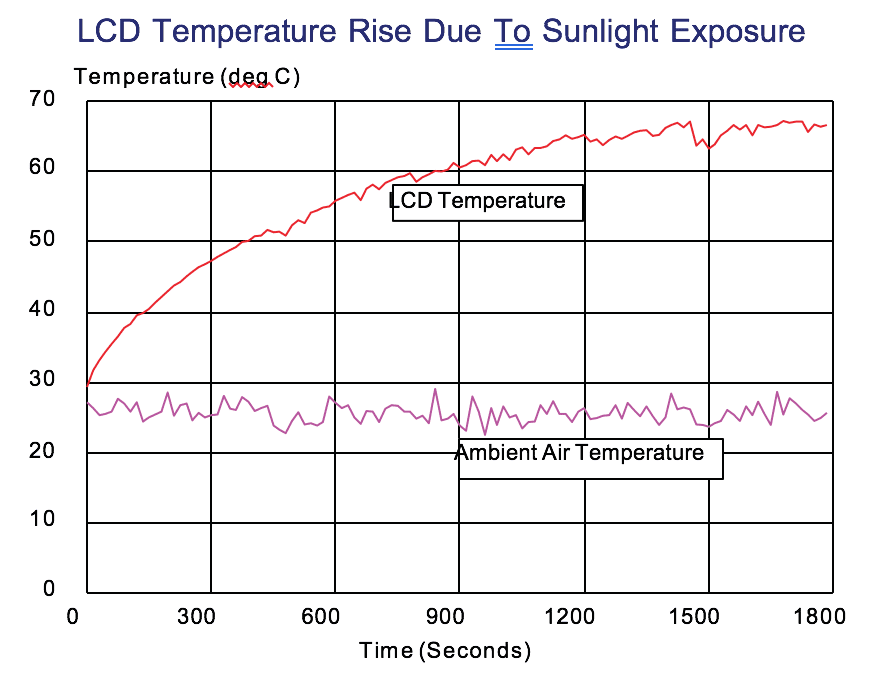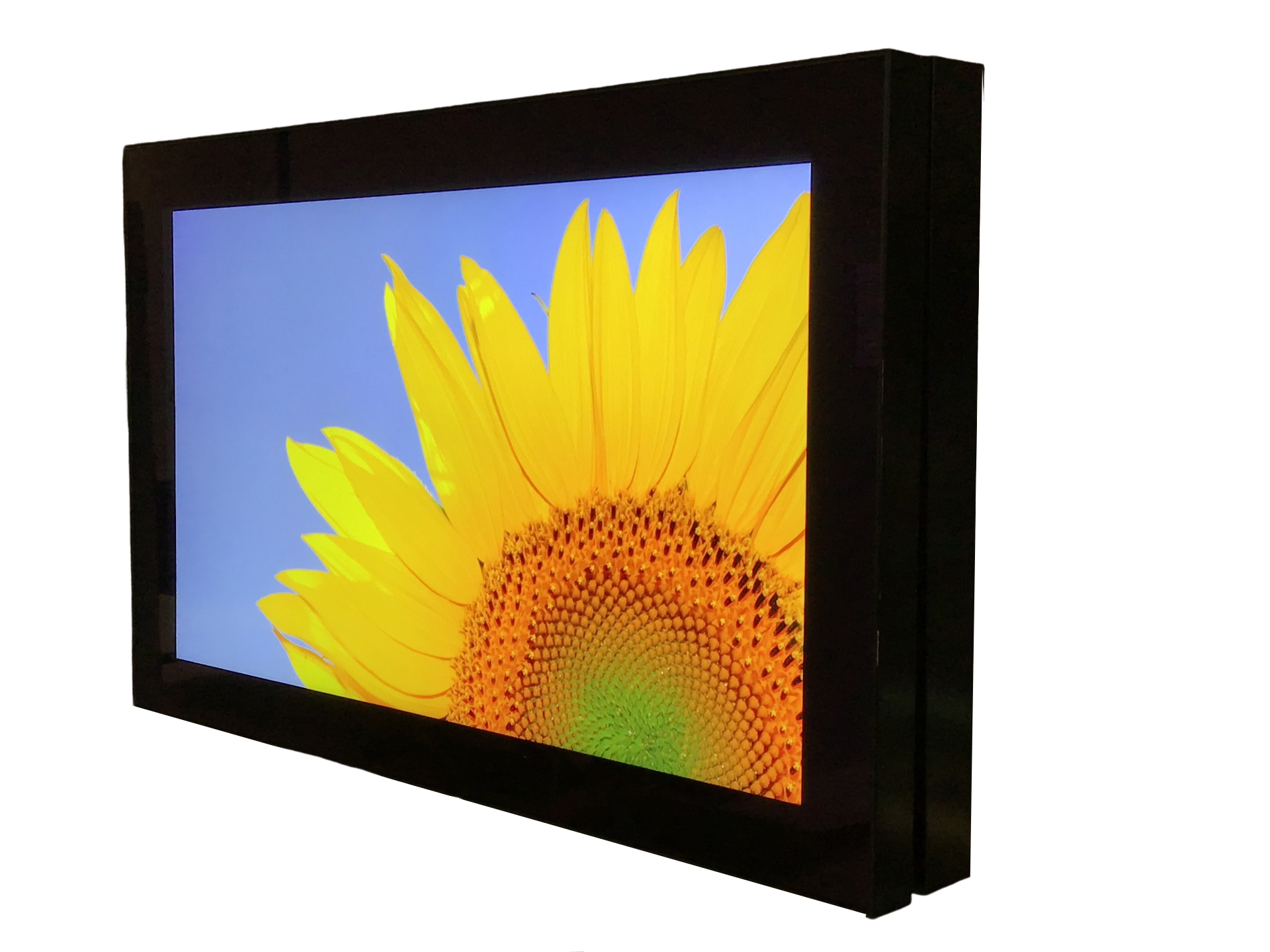How to Prevent an LCD Blackout
The liquid crystal material in an LCD has a transition temperature called the Nematic to Isotropic (N – I) point. This is similar to the transition temperature. Beyond the N – I point, the liquid crystal is no longer in liquid crystal state. As a result, the LCD loses its display effect and an LCD blackout occurs.
In an LCD with TN (twisted nematic) technology, you can have an LCD blackout after the temperature rises beyond the N – I point. To users, this phenomenon happens when “the display goes black”.
Just like the transition between ice and water, the N – I transition is also reversible with generally no permanent damage to the LCD. However, if the LCD goes through too many N – I transitions, there are some secondary effects that can cause a gradual degradation of the display performances.
For example a 5.0” LCD has an operating temperature range from 0 to 50˚C. The factory measures its N – I transition temperature at 82.5 ˚C. As a result, an LCD blackout occurs at about 80˚C and beyond. This is 30˚C above the maximum recommended operating temperature, making this LCD quite suitable for outdoor applications.
The LCD Heating Problem
The very high brightness backlight in a sunlight readable LCD module consumes a significant amount of power that can heat the LCD to a temperature higher than normal. In addition, the front surface of an LCD is a good sunlight absorber. Thus, even for a standard brightness LCD, its temperature can also rise significantly under the direct sunlight illumination.
The exact amount of LCD temperature rise due to these two factors depends on how the LCD module is mounted and also on the heat dissipation design. For example, if the LCD is mounted vertically, a significant portion of the VHB backlight heat will be dissipated into the air without heating up the LCD panel, and as a result, the LCD temperature rise will be low. On the other hand, if the LCD module is mounted horizontally, then almost all of the backlight heat rises to warm up the LCD panel. In addition, if a small fan or a heat sink is mounted onto the VHB backlight, the temperature rise of the LCD panel can be reduced significantly.
Rise in Temperature of a Sunlight Readable LCD Module
Fig. 1 below shows a typical temperature rise curve of a sunlight readable LCD module.
The module is a 10.4” unit operated at 1,500 nits screen luminance with 19 watts backlight power. LCD is tilted at a 25˚ angle from the vertical and is operated in still air (i.e., no forced air cooling). There are six thermal sensors to measure the temperature of the LCD panel at various locations.
The curve shows the average temperature reading of the LCD as a function of the time.
At t = 0 second, the backlight is turned on. Within the first 15 minutes, the LCD temperature rises about 10˚C, and finally settles with a rise of 19.5˚C. However, if a small CPU fan is attached to the back of the VHB backlight, the temperature rise reduces to 8ºC. A similar reduction of the LCD temperature can also be achieved by attaching a heat sink onto the backside of the VHB backlight.
In general, the thermal issues related to the VHB backlight power consumption can be resolved by relatively simple heat dissipation designs.
 TempFig. 1. The Temperature rise curve of a 10.4” LCD VHB Backlight
TempFig. 1. The Temperature rise curve of a 10.4” LCD VHB Backlight
Sunlight and LCD Blackouts
The second major cause of LCD blackout is sunlight itself. LCDs are suitable for outdoor uses because they have a very black front surface. On the other hand, a black front surface can absorb nearly all of the incident sunlight and heat up the LCD. This effect severely increases the thermal management problem when the LCD is exposed to strong direct sunlight.
Fig. 2 shows a typical LCD temperature rise curve due to direct sunlight exposure. Again, the module is a 10.4” unit. During the test, the VHB backlight was not turned on. So the only heating source is the incident sunlight. On the day this test was conducted, the ambient air temperature was about 26ºC.
The sunlight illumination was about 10,300 foot candles incident onto the LCD at the normal direction. The large fluctuation of the air temperature shown in the graph was due to wind blowing onto the thermal sensor.
The LCD temperature curve indicates that with the absorption of the sunlight, the LCD temperature rises by more than 20˚C within the first 5 minutes. After about 30 minutes, the LCD temperature rises by more than 40˚C. This is more than twice the temperature rise caused by the VHB backlight heat.
Why Angles Are Important
The situation shown in Fig. 2 represents the worst case where very bright sunlight shines onto the LCD from a normal direction. If the incident angle of the sunlight is not perpendicular to the LCD, for example, at an angle from the normal direction, then the amount of sunlight power absorbed by the LCD reduces according to the Cosine law. That is:
P = P(0) x cos (? )
Fig. 1. The temperature rise curve of a 10.4” LCD with VHB backlight Where P(0) is the power absorbed when the sunlight incident angle is 0º (at perpendicular direction). For example, at an incident angle of 45˚C, the amount of power absorbed by the LCD will be reduced to 70.7% of the amount if the sunlight hits the LCD at normal direction. Thus, the temperature rise will not be as severe as those shown in Fig. 2. However, for any outdoor application where the LCD will be subjected to direct sunshine, it is necessary to consider the extra heat due to sunlight absorption and provide additional cooling capability to avoid LCD overheating.
 Fig. 2. LCD temperature rise due to sunlight absorption
Fig. 2. LCD temperature rise due to sunlight absorption
Now if we add the heating due to MS VHB backlight and the Sunlight together, the LCD temperature can increase by 40 + 19.5 = 59.5 ºC in the worse case! So, if the ambient temperature is 25 ºC, the LCD can reach about 85 ºC (i.e. 25 + 59.5) which is beyond the 82.5 ºC N – I transition point. Therefore, an LCD blackout occurs.
Suggestions to Avoid An LCD Blackout
An LCD blackout problem can be avoided in two ways:
- Reduce the amount of heating energy
- Reducing the LCD screen from 1,500 nits down to 1,000 nits cuts down the backlight power by 1/3, and as a result, reduces the LCD temperature by up to 6.5 ºC. Therefore an LCD blackout is prevented.
- Using a linear polarizer plate in front of the LCD. Align the polarization axis of this plate to match to the front polarizer of the LCD. This polarizer plate will cut down the amount of sunlight falling onto the LCD by nearly 60%. Therefore, the LCD temperature can be reduced by as much as 24 ºC. In the meantime, the LCD brightness will only be reduced by about 10%.
- In the cases of B, Please make sure that the linear polarizer cover plate is thermally insulated from the LCD, or the heat generated on the cover place is removed by air flow. Otherwise, the sunlight heat generated on the linear polarizer plate is conducted to the LCD eventually and makes it in-effective to reduce the LCD temperature.
- Remove the heat by cooling the LCD to prevent an LCD blackout
- Cooling the LCD by forced air circulation=
- Conduct the heat away from the LCD, for example, to the metal housing.
- Air conditioning the case that houses the LCD.
Please remember that the heat due to the sunlight is generated directly at the LCD front surface. So, it is most effective if the cooling is applied on the LCD front surface directly.
Manual Cooling
If the LCD is cooled by forced air circulation, please make sure the air is clean. Otherwise, as time goes by, dusts and carbon particles in the air will be deposited over the LCD surface. This will ruin the clarity of the display.
- Install the LCD in a position to have a large sunlight incident angle when the sunlight is strongest (for example in noon time during the summer session). A large sunlight incident angle will reduce the amount of sunlight power absorption according to the cosine
Preventing an LCD Blackout
The above are some suggestions to keep the LCD cool and prevent an LCD blackout. However, it is absolutely necessary to test the thermal management designs in the real installations under the worst environment (i.e. on a summer day with very bright sunshine).
It is generally safe to operate the LCD beyond its specified temperature range (for example, at a temperature beyond 50 ºC for a 15” LCD) occasionally or for a short period of time. That being said, we don’t recommend it. Doing this can significantly shorten the LCD lifetime.

